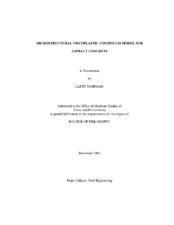| dc.description.abstract | This dissertation presents the development of an anisotropic viscoplastic continuum damage model to describe the permanent deformation of asphalt pavements. The model is developed to account for several phenomena that influence the permanent deformation of Asphalt Concrete (AC) at high temperatures. These phenomena include strain rate dependency, confining pressure dependency, dilation, aggregate friction, anisotropy, and damage. The model is based on Perzyna's theory of viscoplasticity with Drucker-Prager yield function modified to account for the microstructure anisotropy and damage. A parametric study was conducted to study the effect of key factors such as inherent anisotropy and damage on the model response. A preliminary investigation was conducted to demonstrate the capabilities of the model and its sensitivity to changes in the microstructure distribution and loading conditions. The model was used to describe laboratory experimental measurements obtained from the Federal Highway Administration (FHWA) Accelerated Loading Facility (ALF). The model had a good match with these experimental measurements. In particular, using the damage parameter, the model was able to capture the point at which AC experienced tertiary creep in a static creep test. A comprehensive experiment was conducted to systematically determine the model parameters and the evolution laws that describe AC hardening, anisotropy, and damage. The experiment consisted of a set of compressive triaxial strength tests conducted at three confining pressures and five strain rates. Based on these experimental measurements, the model was modified to include a nonassociated flow rule. The model was shown to capture the experimental measurements very well. Furthermore, an experiment was conducted to capture and characterize damage evolution in AC due to permanent deformation. AC specimens were loaded using a triaxial compression setup to four predefined strain levels at three confining pressures. X-Ray computed tomography and image analysis techniques were used to capture and characterize the evolution of cracks and air voids in the deformed specimens. Damage was found to be a localized phenomenon in the sense that there exists a critical section in an AC specimen that is mainly responsible for failure. The results of the damage experiment supported the damage evolution function proposed in the viscoplastic model. | en |


